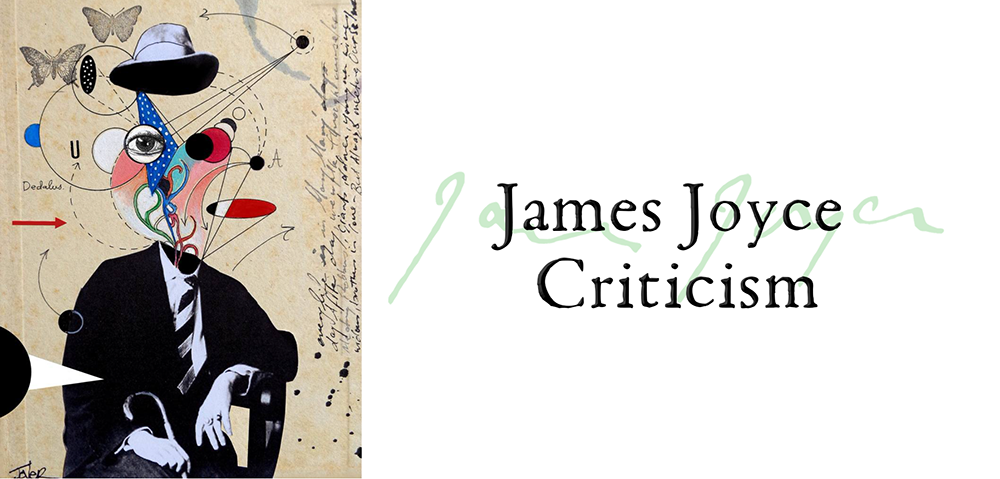Joyce Criticism: “Finnegans Wake” 3. Criticism 2000-Present
- At January 06, 2022
- By Great Quail
- In Joyce
 0
0
Finnegans Wake: Criticism 2000–Present
The works profiled below are literary criticism generally intended for advanced readers; beginner’s guides and annotations are described under their own section. The books are listed by publication date. Clicking a cover image takes you to Amazon.com. When Brazen Head commentary is unavailable, the publisher’s summaries are usually reprinted. If any knowledgeable Joyce reader would like to review, summarize, or provide additional information for any of these “uncommented” books, please drop us a line! Additional Wake criticism may be found by clicking the links below:
Finnegans Wake Criticism
[Main Page | Guides & Annotations | Criticism 1929-1999 | Criticism 2000-Present | About the Wake | Independent]
The Wake Newslitter CD
The Wake Newslitter CD
Split Pea Press, 2000
Available online at: JoyceTools
Description from Split Pea Press: This CD-ROM contains the complete run of the A Wake Newslitter journal. This journal was dedicated to the study of James Joyce’s Finnegans Wake. The package contains the 18 issues comprising the Old Series and the 102 issues comprising the New Series along with the 4 Occasional Papers and the volume entitled A Wake Digest. All files use Adobe Acrobat PDF software. This disc is Macintosh and Windows compatible.
Commentary by Ross Chambers: I can only add that the material contained represents a moderated collection from many of the most prominent Wake critics of the period, critics who laid the groundwork for current studies, and whose perceptions and concepts are still to be fully explored. The complete run allows a timeline of Finnegans Wake studies, from annotation, establishment of commonly accepted themes, and eventually to genetic studies. It may be difficult to find this journal in print form. The usually thorough Fisher Research Library of the University of Sydney has a collection which over time has become incomplete, the Newslitter, particularly in its early issues didn’t seem to qualify for the journal binding list.
Wake Rites: The Ancient Irish Rituals of Finnegans Wake
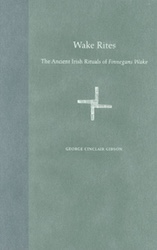
Wake Rites: The Ancient Irish Rituals of Finnegans Wake
By George Cinclair Gibson
University Press of Florida, 2005
Publisher’s Description: Many scholars of Finnegans Wake have long suspected that a key to the Wake lay deep within the core of Irish myth. George Gibson proposes a new interpretation of the novel, based upon a previously unrecognized paradigm from Irish mythology underlying the entirety of the work. This mythic structure derives from the ancient rituals and events collectively known as the Teamhur Feis (the Rites of Tara), the most important religious festival conducted in pre-Christian Ireland. Gibson demonstrates that sources known and used by Joyce describe the Rites as a historical event with nationwide attendance, an extraordinary and complex array of Druidic ritual, mystical rites, historical reenactments, sacred drama, conclaves, assemblies, and ceremonies performed by a bizarre cast of characters ranging from representatives of Irish deities and personifications of abstract principles to Druids, magistrates, ritual functionaries, and reenactors of the mythic dead. In Irish tradition, the most significant performance of this pagan spectacle occurred in 433 A.D., when Saint Patrick arrived at Tara just as the Rites were reaching their climax. Gibson argues that this pivotal event is also the climax of Finnegans Wake. Demonstrating remarkable parallels between specific events and performers of the Rites and the episodes and characters comprising Finnegans Wake, Gibson shows that every event and performer at the Rites has a correlate in the novel, and all Wakean episodes and performers have their parallels in the Rites of Tara. Ultimately, he argues, Joyce structured his novel according to the Teamhur Feis, and Finnegans Wake is a calculated reenactment of the most important event in Irish paganism.
Joyce’s Kaleidoscope: An Invitation to Finnegans Wake
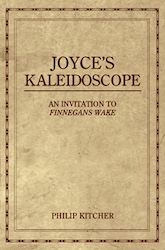
Joyce’s Kaleidoscope: An Invitation to Finnegans Wake
By Philip Kitcher
Oxford University Press, 2009
Publisher’s Description: James Joyce’s Ulysses, once regarded as obscure and obscene, is now viewed as one of the masterpieces of world literature. Yet Joyce’s final novel, Finnegans Wake, to which he devoted seventeen years, remains virtually unread, except by scholarly specialists. Its linguistic novelties, apparently based on an immense learning that few can share, make it appear impenetrable. Joyce’s Kaleidoscope attempts to dissolve the darkness and to invite lovers of literature to engage with Finnegans Wake. Philip Kitcher proposes that the Wake has at its core an age-old philosophical question, “What makes a life worth living?”, and that Joyce explores that question from the perspective of someone who feels that a long life is now ending. So the complex dream language is a way of investigating issues that are hard to face directly; the reader is invited to struggle with the novel’s aging dreamer who seeks reassurance about the worth of what he has done and been. Joyce finds his way to reassurance. The sweeping music and the high comedy of Finnegans Wake celebrate the ordinary doings of ordinary people. With great humanity and a distinctive brand of humanism, Joyce points us to the things that matter in our lives. His final novel is a festival of life itself. From this perspective, the supposedly opaque, or nonsensical, language opens up as a rich source for the reader’s reflections: though readers won’t all approach it the same way, or with the same set of references, there is meaning in it for everyone. Kitcher’s detailed study of the entire text brings out its musical resonances and its musical structures. It analyzes the novel overall while bringing deep insight to the reading of key individual passages. This engaging guide will aid readers not just to make sense of the novel, but to relish the remarkable accomplishment of Joyce’s least appreciated work.
Contents:
1. So soft this morning, Ours
2. His Reignbolt’s Shot
3. Respectable
4. Nayman of Noland
5. Crossmess parzel
6. Life’s Robulous Rebus
7. Three score and ten toptypsical readings
8. The Hubbub Caused in Edenborough
9. The unfacts, did we possess them, are too imprecisely few to Warrant our Certitude
10. Everybody Heard their Plaint
11. Tell Me More
12. Loud, Heap Miseries upon us
13. The tasks Above are as the Flasks below
14. From Liff Away
15. The Four of Us and Sure, Thank God, There are No More of Us
16. A Picture Primitive
17. Lightbreakfastbringer
18. Arise, Sir Ghoscus!
19. Male and Female Unmask We Hem
20. The Keys to. Given!
21. Aisy Now, You Decent Man
I Know That I Have Broken Every Heart: The Significance of the Irish Language In Finnegans Wake
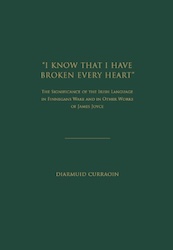
I Know That I Have Broken Every Heart: The Significance of the Irish Language In Finnegans Wake
By Diarmuid Curraoin
Academica Press/Maunsel & Company, 2014
Publisher’s Description: The central theme of this monograph is James Joyce’s employment of the Irish language in Finnegans Wake, the virtuosity with which he makes use of the tongue, the understanding of its grammatical and syntactical subtleties which he reveals in the book and “the explanatory treasure of heart and mind,” as the the author put it himself, which the Gaelic component of the writer’s final word on the world provides. Since Finnegans Wake cannot be viewed in total isolation from the greater Joycean canon, the interconnections between it and Joyce’s other writings, both fictional and journalistic, will be examined as will his deployment of other languages, notably his use of that second “Irish” language Hisperic or Hiberno-Latin. James Joyce’s employment of the Irish language in Finnegans Wake is an area of study upon which little serious scholarly work has been done prior to study, an extraordinary situation when one considers that, firstly, the author declares in the book Irish to be the second language of the Wake and secondly, that there is hardly a page of the novel which does not contain at least one Irish language element, features which range from the simple and obvious to the extremely complex and obtuse. More importantly, in a sense, however, is the fact that it is in Irish in Finnegans Wake that the writer reveals his deepest personal concerns, worries in regard to the illness of his daughter Lucia, the manner in which his lifestyle has impacted upon his wider family, the state in which Ireland finds herself and the way in which he is viewed at home. A complete understanding of James Joyce, author, father, Irishman, cannot be achieved in the absence of a full appreciation of his relationship with the Irish tongue.
Contents:
1. Finnegans Wake and the politics of space, time and the sub-conscious mind
2. The dream of the black panther—James Joyce and the struggle for national self-realisation
3. “I know that I have broken every heart”—The secret messages in Irish of Finnegans Wake
4. The little black rose—the Fenian and Red Branch mythic cycles in Finnegans Wake
5. The mythic and metaphysical Irish in the works of James Joyce
6. The sayings of the west—Finnegans Wake and the Hisperica Famina
7. “Faithful to herself”—James Joyce and questions of Irish linguistic identity
8. Less than lovers, more than friends—images of Ireland in Finnegans Wake
Joyce’s Allmaziful Plurabilities: Polyvocal Explorations of Finnegans Wake
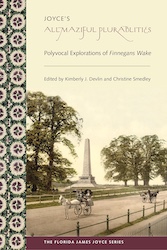
Joyce’s Allmaziful Plurabilities: Polyvocal Explorations of Finnegans Wake
Edited by Kimberly Devlin and Christine Smedley
University Press of Florida, 2015
Publisher’s Description: This is the first Finnegans Wake guide to focus exclusively on the multiple meanings and voices in Joyce’s notoriously intricate diction. Rather than leveling the text it illuminates many layers of puns, wordplay, and portmanteaus, celebrating the Wake’s central experimental technique. Renowned Joyce scholars explore the polyvocality of individual chapters using game theory, ecocriticism, psychoanalysis, historicism, myth, philosophy, genetic studies, feminism, and other critical frameworks. They set in motion cross-currents and radiating structures of meaning that permeate the entire text and open up satisfying readings of the Wake for novices and seasoned readers alike.
Contents:
- Kimberly J. Devlin and Christine Smedley: Introduction
- John Terrill, “The ‘gift of seek on site’”
- Jim LeBlanc, “Here Comes Everybody”
- Tim Conley, “Weathering the Text”
- Mia L. McIver, “Habeas Corpus Epiphany in I.4”
- Colleen Jaurretche, “Joyce’s Common Reader”
- Sean Latham, “Playful Reading”
- Christine Smedley, “Shem’s ‘strabismal apologia’”
- Margot Norris, “Fluid Figures in Anna Livia Plurabelle”
- Carol Loeb Shloss, “Moveable Types”
- Jeffrey Drouin, “MUTUOMORPHOMUTATION”
- Enda Duffy, “Irish History and Modern Media”
- David Spurr, “Joyce’s Countergospel in II.4”
- Kimberly J. Devlin, “Salvation, Salves, Saving, and Salvage”
- Patrick A. McCarthy, “Jaunty Jaun’s Brokerly Advice in III.2”
- Sheldon Brivic, “The Daughter in the Father”
- Richard Brown, “The Porters, Polypragmatic Paradigms, and Pseudoselves in III.4”
- Vicki Mahaffey, “Ricorso”
The Ecology of Finnegans Wake
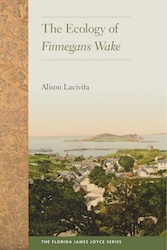
The Ecology of Finnegans Wake
By Alison Lacivita
University Press of Florida, 2015
Publisher’s Description: In this book—one of the first ecocritical explorations of both Irish literature and modernism—Alison Lacivita defies the popular view of James Joyce as a thoroughly urban writer by bringing to light his consistent engagement with nature. Using genetic criticism to investigate Joyce’s source texts, notebooks, and proofs, Lacivita shows how Joyce developed ecological themes in Finnegans Wake over successive drafts. Making apparent a love of growing things and a lively connection with the natural world across his texts, Lacivita’s approach reveals Joyce’s keen attention to the Irish landscape, meteorology, urban planning, Dublin’s ecology, the exploitation of nature, and fertility and reproduction. Lacivita unearths a vital quality of Joyce’s work that has largely gone undetected, decisively aligning ecocriticism with both modernism and Irish studies.
James Joyce and the Philosophers at Finnegans Wake
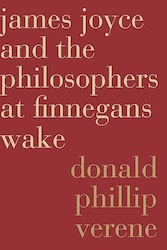
James Joyce and the Philosophers at Finnegans Wake
By Donald Phillip Verene
Northwestern University Press, 2016
Publisher’s Description: James Joyce and the Philosophers at Finnegans Wake explores how Joyce used the philosophers Nicholas Cusanus, Giordano Bruno, and Giambattista Vico as the basis upon which to write Finnegans Wake. Very few Joyce critics know enough about these philosophers and therefore often miss their influence on Joyce’s great work. Joyce embraces these philosophic companions to lead him through the underworld of history with all its repetitions and resurrections, oppositions and recombinations. We as philosophical readers of the Wake go along with them to meet everybody and in so doing are bound “to encounter for the millionth time the reality of experience and to forge in the smithy” of our souls the “uncreated conscience” of humankind. Verene builds his study on the basis of years of teaching Finnegans Wake side by side with Cusanus, Bruno, and Vico, and his book will serve as a guide to readers of Joyce’s novel.
Contents:
Introduction: Plato’s Ancient Quarrel
1. Beckett’s Exagmination
2. Joyce’s Philosophical Vocabulary
3. Bruno’s Equals of Opposites and Cusanus’s Learned Ignorants
4. Vico’s Vita and the Producer (Mr. John Baptister Vickar)
5. Vico’s Science and the Millwheeling Vicocyclometer
Appendix: Register of Philosophers at the Wake
Beating the Bounds: Excess and Restraint in Joyce’s Later Works
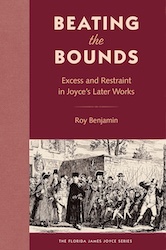
Beating the Bounds: Excess and Restraint in Joyce’s Later Works
By Roy Benjamin
University Press of Florida, 2023
Publisher’s Description: Examining the role of boundaries and limits in James Joyce’s later works, primarily Finnegans Wake but also Ulysses and other texts, this book explains and reconciles Joyce’s contrary tendencies to establish and transgress limits and shows the Wake’s relevance to many different fields of thought.
The Avant-Postman: Experiment in Anglophone and Francophone Fiction in the Wake of James Joyce
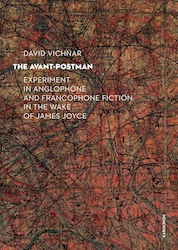
The Avant-Postman: Experiment in Anglophone and Francophone Fiction in the Wake of James Joyce
By David Vichnar
Karolinum Press, Charles University, 2024
Publisher’s Description: The Avant-Postman explores a broad range of innovative postwar writing from France, Britain, and the United States. Taking James Joyce’s Ulysses and Finnegans Wake as a joint starting point, David Vichnar draws genealogical lines from there through the work of more than fifty writers up to very recent years, including William Burroughs, B. S. Johnson, Ian Sinclair, Kathy Acker, Alan Moore, David Foster Wallace, and many others. Centering the exploration around five strategies employed by Joyce—narrative parallax, stylistic metempsychosis, concrete writing, forgery, and neologizing the logos—the book reveals the striking continuities and developments from Joyce’s day to our own.
Philosophical Allusions in James Joyce’s Finnegans Wake
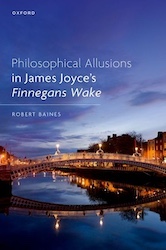
Philosophical Allusions in James Joyce’s Finnegans Wake
By Robert Baines
Oxford University Press, 2024
Publisher’s Description: Philosophical Allusions in James Joyce’s Finnegans Wake is the first study to offer complete and comprehensive explanations of the most significant philosophical references in James Joyce’s avant-garde masterpiece. Philosophy is important in all of Joyce’s works, but it is his final novel which most fully engages with that field. Robert Baines shows the broad range of philosophers Joyce wove into his last work, from Aristotle to Confucius, Bergson to Kant. For each major philosophical allusion in Finnegans Wake, this book explains the original idea and reveals how Joyce first encountered it. Drawing upon extensive research into Joyce’s notebooks and drafts, Baines then shows how Joyce developed and adapted that idea through repeated revisions. From here, the final form of the idea as it appears in the Wake is explored. In carefully examining the Wake’s key philosophical allusions, essential themes within the novel come into focus, including history, time, language, being, and perception. We see also how those allusions combine to create a network of ideas, thinkers, and texts which has a logic and an integrity. Ultimately, Philosophical Allusions in James Joyce’s Finnegans Wake shows that the more one knows of the Wake’s philosophical allusions, the more one can find meaning and reason in this famously perplexing book of the night.
Guilt and Finnegans Wake: From Original Sin to the Irredeemable Body

Guilt and Finnegans Wake: From Original Sin to the Irredeemable Body
By Talia Abu
University Press of Florida, 2025
Publisher’s Description: James Joyce’s last novel, Finnegans Wake, is notorious for its complex structure and considered by many to be unreadable. Approaching this complicated book with attention to the theme of guilt, an important concept that has been under-explored in studies of the Wake, Talia Abu presents a clear and thorough interpretation that helps illuminate the book for even the most novice Joyce readers. In Guilt and Finnegans Wake, Talia Abu examines how Joyce portrays the evolution of cultural beliefs about morality, from the concept of a moral code set in place by a transcendental authority to an embodied morality that originates in material existence. Through close readings of the novel, Abu demonstrates that Joyce engages with guilt as it relates to the Catholic doctrine of original sin, the institution of the marriage contract, the theories of Nietzsche, and the views of Freud—including Freud’s emphasis on the physical experience as the primary aspect of being. Ultimately, Abu argues that Joyce sees guilt as a personal and unique experience and that emotions such as guilt can be reclaimed from the influence of religious and social institutions. Delving into Joyce’s representation of historical events while also analyzing Joyce’s wordplay and linguistic techniques and drawing from multiple disciplines to understand different conceptions of guilt, this book shows the importance of the theme to the form of Finnegans Wake and Joyce’s craft more broadly. Pursuing the questions and ideas that Joyce raises about guilt and morality, Talia Abu makes a case for the enduring relevance of Joyce’s work today.
CONTINUE TO > About the Wake
Joyce Criticism
[Main Page | General Criticism | Dubliners | Portrait | Ulysses | Finnegans Wake]
Author: Allen B. Ruch
Artwork: Loui Jover
Last Modified: 14 June 2024
Main Joyce Page: The Brazen Head
Contact: quail(at)shipwrecklibrary(dot)com

